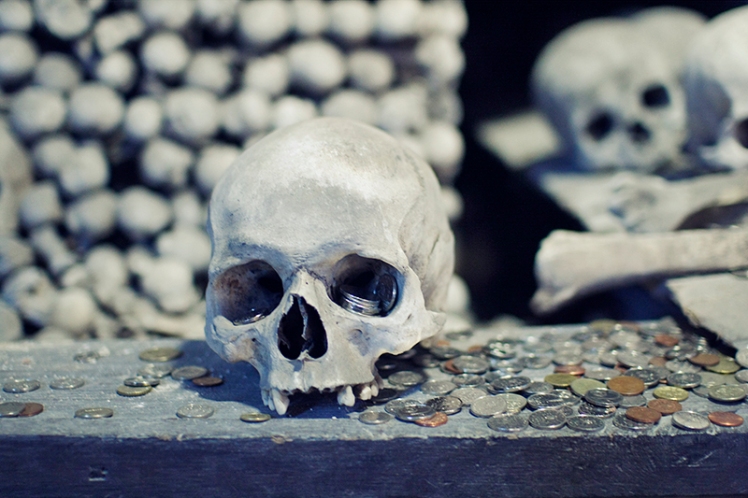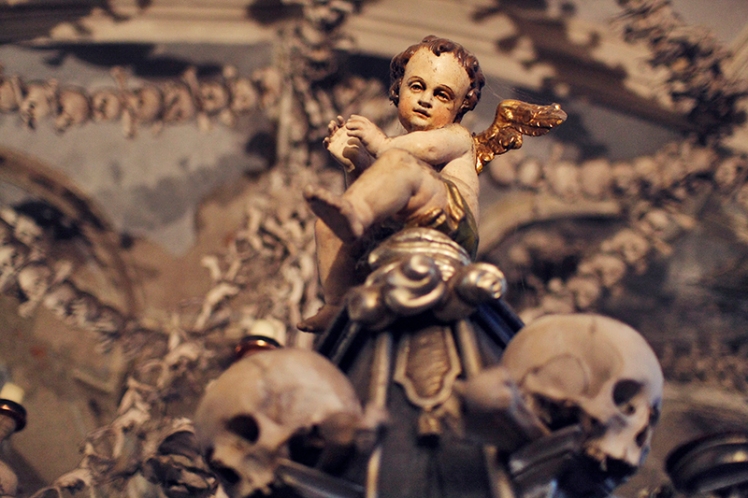Them bones, them bones need…..their picture taken…..money thrown at them…..a light dusting. I finally got round to visiting the beautiful town of Kutna Hora on Tuesday when we had a bank holiday in the Czech Republic. It seems to be one of the few places that a lot of my colleagues in work visit and yet I had never made it there myself, despite all of our other adventures around the country.
I left it a little bit late to get there and further shot myself in the foot by getting on a train that was only going as far as Prelouc, after which we would have to board a bus to take us to Kolin, the nearest big town. Sure enough the bus wound it’s way around all the little villages along the way and a journey that should have taken around half an hour took more than an hour in the end…..oops.
The journey to Kutna Hora is a pleasantly short trip on a little two carriage train that slowly rattles through the countryside south of the river Labe. Once you reach the station, it’s a fairly short walk to the Ossuary, the first port of call on my trip. At 90kc entry, it’s a little steep but it’s worth it once you see the sheer spectacle inside the monastery. There’s literally hundreds of thousands of bones on display and for me at least, there was nothing morbid or disrespectful about it. I’m not sure how much that would change if it were people I knew but it’s a strangely beautiful homage to the lives of those whose remains adorn the various displays within.
And now for some history, courtesy of www.ossuary.eu:
A cistercian monastery was founded near here in the year 1142. One of the principal tasks of the monks was the cultivation of the grounds and lands around the monastery. In 1278 King Otakar II of Bohemia sent Henry, the abbot of Sedlec , on a diplomatic mission to the Holy Land. When leaving Jerusalem Henry took with him a handful of earth from Golgotha which he sprinkled over the cemetery of Sedlec monastery, consequently the cemetery became famous, not only in Bohemia but also throughout Central Europe and many wealthy people desired to be buried here.The burial ground was enlarged during the epidemics of plague in the 14 th century (e.g.in 1318 about 30 000 people were buried here) and also during the Hussite wars in first quarter of the 15 th. century.
After 1400 one of the abbots had a church of All -Saints erected in Gothic style in the middle of the cemetery and under it a chapel destined for the deposition of bones from abolished graves, a task which was begun by a half blind Cistercian monk after the year 1511. The charnel-house was remodelled in Czech Baroque style between 1703 – I710 by the famous Czech architect, of the Italian origin ,Jan Blažej SANTIM-Aichl. The present arrangement of the bones dates from 1870 and is the work of a Czech wood-carver, František RINT (you can see his name, put together from bones, on the right-hand wall over the last bench).
Our ossuary contains the remains of about 40 000 people. The largest collections of bones are arranged in the form of bells in the four corners of the chapel.
The most interesting creations by Master Rint are the chandelier in the centre of the nave, containing all the bones of the human body , two monstrances beside the main altar and the coat-of arms of the Schwarzenberg noble family on the left-hand side of the chapel.
And now for some photos, courtesy of my trusty camera:











































I went here when I studied abroad! I couldn’t remember the name but I recognized it instantly, obviously.
Its a pretty cool place, creepy and slightly disrespectful but cool all the same 🙂